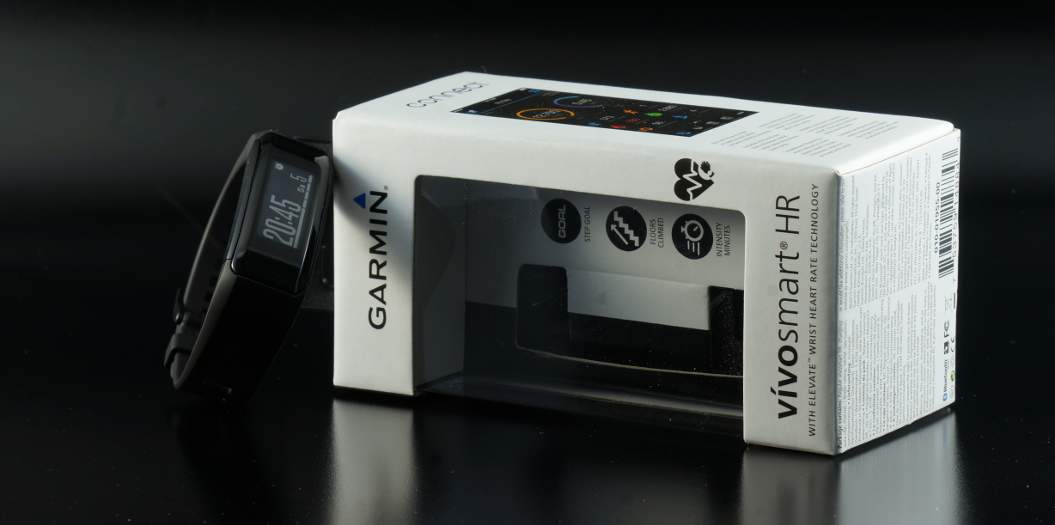In this Garmin Vivosmart HR test and experience report, we highlight this versatile fitness band with built-in pulse sensor. The Vivosmart HR brings numerous features with it and more than just activity tracker functions. In addition to the 24×7 heart rate sensor, the device also features smart watch functions and a touch display. Let us take a closer look at the Vivosmart HR in practice.
What’s in it – Unboxing and haptics
Let’s start the Garmin Vivosmart HR test with the Unboxing. The Vivosmart HR is very different from its predecessor, the Vivosmart. Not only do they have completely different form factors, but there are also differences in the features. The newer Vivosmart HR has received new features (such as an optical heart rate sensor), but also lost features of its predecessor. We will look at the differences later in the Vivosmart HR test.
First impression
There are several color and size variations (Black, Violet and Midnight Blue) available. Vivosmart HR has a high quality finish and a sporty look. It is also very light (29.6 g (1.0 oz), Regular; 32.0 g (1.1 oz), X-large) so that you would hardly notice it. The default size of the band is for wrists from 136 to 187 mm and the XL-size from 180 to 224 mm suits large wrists.
The packaging content:
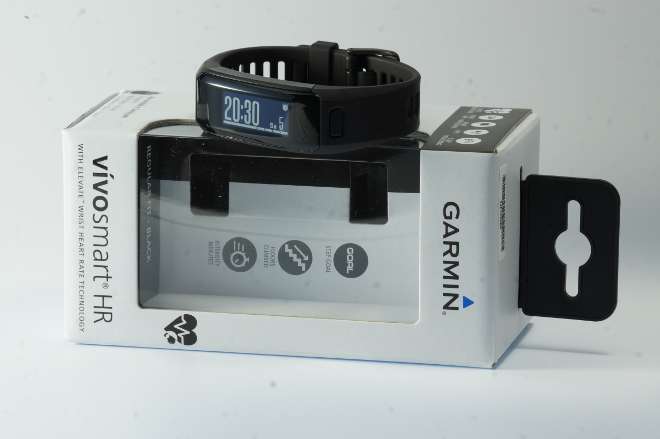
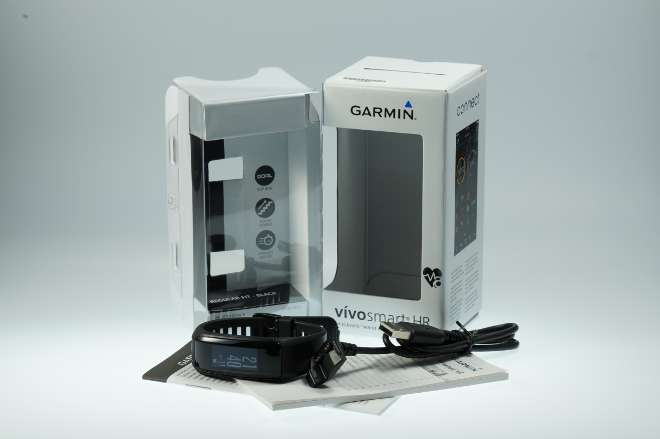
In the packaging is the fitness band itself, including also a USB charging cable with a device-specific interface, via which the Vivosmart HR is charged, and there is also optional sync with Garmin Connect.
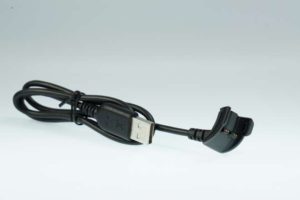
Handling & Customization
Connecting the supplied USB charging cable can be slightly fiddly and requires a little practice at the beginning, because the pins of the charging clamp must be pressed against the contacts on the back of the device until the charging clamp engages.
The actual unit is fixed to the band, so there is no way the band can be swapped for another. This should be taken into account when choosing the color.
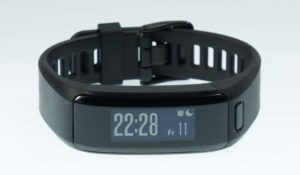
The comfort and the feel of the band is good, because it is made of soft silicone. The band is overall successful, because it is easy to put on and lies comfortably on the skin and sits securely.
Set up
The initial setup and synchronization of the Garmin Vivosmart HR can be done directly using the Garmin Connect app on the smartphone (Android, iOS or Windows Phone) or alternatively on the PC (Windows XP and higher) or Mac (OS X 10.6 or higher). If you already have a Connect account, the personal data as well as previous activities are carried over.
Synchronization of the activity data can be carried out wirelessly at any time. The synchronization with the Connect App is quick and is much faster when compared to the comparable polar A360 for example.
Display
In the Garmin Vivosmart HR review we were able to get a good overview of the display. The negative LCD display is always on and easy to read even in sunlight. In darker environments, you can also activate a backlight so that readability is ensured. The backlight is fairly restrained, but enough so that for example, the roommate is not disturbed in the bedroom due to the brightness of the display.
The backlight can be switched on by a simple wrist movement (can be deactivated) or by tapping/swiping on the display. The light is also automatically activated for alarms and messages.
Service
The touch function (swipe and tap) display is excellent, and the change between the data and menu pages functions reliably. Because the display is generously dimensioned, the functions and symbols can specifically select and execute functions, unless the display is very wet. Overall, the display is very exemplary.
The fitness band Vivosmart HR also has a control button that can be operated by applying slight pressure. This prevents the key from accidentally triggering functions. By pressing the button, you enter the menu of the fitness wristband in which basic settings can be changed, and even sports activities can be started.
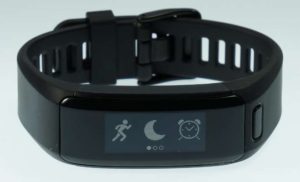
The Garmin Vivosmart HR captures activities with the internal accelerometer, which detects the movements of the wrist, analyzing frequency, intensity, calories burned, sleep patterns and regularity of wrist movements. This allows the activity tracker to determine how active the user is in daily life.
Much of the recorded data can be read directly on the display of the fitness band in addition to the time and date. With a swipe you can reliably reach the next data page. The data pages are presented in more detail below.
General notes on Activity-Trackers (Manufacturer-Independent)
As for the accuracy of steps or burned calories of an activity tracker in general: If you have already dealt with the topic, you have quickly noticed that the perfect tracker is not really there yet. One must know that an activity tracker, independently of the manufacturer, can interpret the arm movements during brushing as steps, for example. If, on the other hand, you are riding a bicycle, there are probably no steps to be counted for most manufacturers, since the arm and body movements do not occur. It is important to have motivation with an activity tracker. And this works best with daily goals. For example, 10,000 steps (generally recommended number of day steps) are determined. Once you have achieved your goal, you know whether you have moved enough or not.
Vital data
Steps: The total number of steps for the day, the daily goal steps add to the progress in achieving the goal. The accuracy of the step counting can be described as very good with the Vivosmart HR, since steps are detected reliably (from approx. 7-8 contiguous steps) and pure arm movements (for example while sitting) are rarely counted.
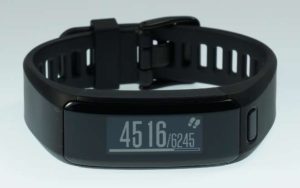
Heart Rate: Current heart rate, and the average of the heart rate at rest for seven days (in beats per minute, bpm.) The heart icon flashes when it is looking for the pulse signal. Until the display shows the current heart rate, it takes a few seconds in our Garmin Vivosmart HR trial, depending on the environmental parameters and skin type. With our test person, it was about 10 seconds.
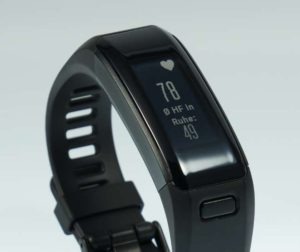
Calories: The calorie consumption of the current day, including active-calories and calories at rest.
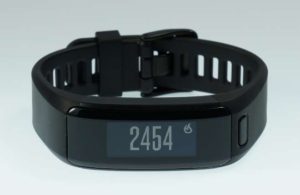
Distance: The current day distance traveled in miles or kilometers.

Floors climbed: The fitness band has a barometric altimeter which determines differences in height and can thus detect floors climbed, for example.
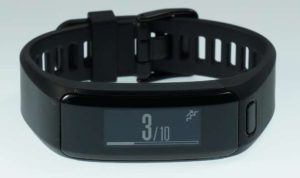
Sleep Behavior: Detects automatically if the user is sleeping. The sleep data can only be accessed in Garmin Connect. More on that later.
Tip: The Garmin Vivosmart HR should be worn on the non-dominant hand to achieve the most accurate Activity Tracking.
Daily targets
The Garmin Vivosmart HR can track an individual activity Target automatically every day. In the Garmin Vivosmart HR trial, it automatically generated a daily goal for daily steps, based on the current activity level. While active during the day, the unit displays the progress with regard to the day’s goal. If you do not enable the automatic goal feature, you can set up an individual daily goal in Garmin Connect.
The progress of the daily goal is displayed in the form of a horizontal bar on the page for the steps, which fills with color as you approach your goal.
Motivational Inactivity Alarm
The Garmin Vivosmart HR recognizes when you have been inactive for too long, for example because of overly long sitting sessions. If one is seated for a long time, the metabolic state can change negatively.
After about 1 hour of sitting the Vivosmart HR reports through an inactivity bar on the main page (under the time and date) and reminds one to stand up and take action to stimulate blood circulation, metabolism and energy metabolism. After an inactivity period of 15 minutes, additional segments are added. After 2 hours, the user is then actively prompted by a vibration as well as an acoustic and visual alarm to move.
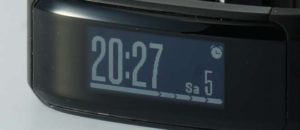
To reset the activity status, you should take a short walk, do stretching exercises or other light activity. A few steps through the apartment, however, is not enough. It is only after approximately 2 minutes of intensive and continuous movements that it is possible to reset the activity status.
Vivosmart HR as sleep tracker and alarm clock
What most current fitness bands can and now also the Vivosmart HR can, is the fully automatic sleep tracking. In our Garmin Vivosmart HR test, the device does not show any problems and reliably automatically detects sleep phases of the user. By using the alarm function, it vibrates the fitness band wake up the user. If you didn’t feel like getting up, you can snooze (10 minutes).
The recorded sleep statistics provide information on the total number of hours of sleep, sleep stages and the movement during sleep.
Garmin Vivosmart HR Test: Sport & Heart Rate Sensor
As soon as you activate the training mode, the integrated heart rate sensor records the heart rate more frequently and thus more accurately over time. In addition, the display is inverted (light background, dark characters) to indicate that you are in the sports mode.
Note on heart rate sensor for the end consumer market
Fitness bands and Fitness Trackers with built-in pulse sensors, such as the one tested here, should be used by users to support recording their workouts and their lifestyle and contribute to the motivation for more activity and movement in daily life. These are not medical devices and the data should not be used to make medical decisions (eg. as prevention, diagnosis, monitoring or treatment of illness or injury) or to replace the advice of a health professional. This is also one of the reasons why manufacturers equate the terms pulse rate and heart rate, even though these are two different things. As a rule, the manufacturers apply the devices uniformly as a heart rate monitor/sensor. The manufacturers also generally exclude any suitability of the devices for use for medical purposes.
If in doubt, always consult a doctor if you are not sure. Especially if you want to use the device in combination with a pacemaker or other medical devices.
Record activities
As soon as the icon (runner) is pressed, the Vivosmart HR is already looking for a heart rate signal. This usually takes about 10 seconds, and will be updated until the display of the heart rate. A good value, but it can vary depending on the skin color and environment. With darker skin types, with tattoos on the skin, cold skin or not yet excited blood circulation, for example, can also take longer.
The timer is started by pressing the control key and the actual activity is recorded. During the training 4 customizable data pages can be displayed and scrolled through using left/right swipe gestures on the device. In Garmin Connect, the data pages displayed can be adjusted. Each data page can display two fields . Thus, during a unit a total of up to eight data fields can be displayed.
Among selectable data fields are: time, calories, distance, heart rate and heart rate zones. Here is an example of two fields (pulse and distance) on a data page:
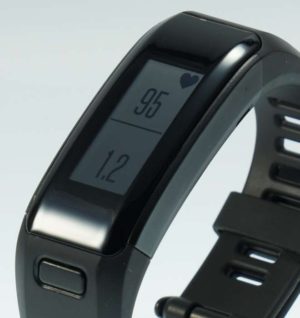
Tip: During training sessions, the fitness band should be tight to achieve the most accurate pulse values. As with all optical pulse meters, it is also useful to warm up your skin a little and to stimulate your blood circulation (for example, by warm-up exercises), otherwise inaccurate values will be determined at the beginning of the training.
To interrupt a training session, press the control button of the Vivosmart HR, which then stops the timer. To resume recording the exercise, press the button again. To terminate the recording of a training unit, either type the icon to save or delete. When deleting, the device asks if the unit should actually be cleared.
Accuracy of Fitness Data
After synchronization with Connect, the data is available for further analysis. In Connect, a sport art and comments can be assigned.
The following is a sample of data from a test run. In the Garmin Vivosmart HR test, we tested the Vivosmart HR against a Garmin Premium HR chest strap, which was coupled to the Garmin Fenix 3 (our Fenix 3 test). The premium chest strap is known for very accurate HR frequency recordings.
It is clear that the Vivosmart HR has difficulties getting started. This can have many causes. In this case, presumably because the test runner has not warmed up prior. However, the values are largely comparable, with the HR chest strap recording more detailed values and the optical pulse sensor reacting somewhat delayed, which is typical. Further comparison values:
- Average heart rate
- Vivosmart HR: 167 bpm
- HR-Premium chest strap: 171 bpm
- Max. heart rate
- Vivosmart HR: 184 bpm
- HR-Premium chest strap: 184 bpm
- Distance
- Vivosmart HR: 2.9 km (if one knows and knows the own step length, better distance values are possible)
- Garmin Fenix 3: 2,4 km (via GPS)
Overall, one can say that for hobby athletes the accuracy of the pulse sensor is sufficient, while ambitious athletes could be dissatisfied at this point and would have to invest more money into a more cost-intensive tracker.
Vivosmart HR Smart Notifications
We use the Garmin Vivosmart HR test to try the smart help functions of the fitness band. These include, in particular, smart notifications.
By existing Bluetooth connection to the smartphone, smartphone notifications including message content can be displayed on the display of the Garmin Vivosmart HR. The device informs the user on its display and/or vibration alarm on the following messages:
- incoming calls including caller- (Caller-) ID. When an incoming call is displayed on the device, this can be accepted or rejected on display icons. Missed calls are also displayed.
- (Text) messages (such as text, call, email, calendar and social media alerts): When a notification is displayed on the device, the notification (Content limited to 350 characters) can be displayed or discarded.
- Calendar entries on your smartphone: Operating as text messages.
When you receive a notification, the Garmin Vivosmart HR informs you by vibrating and offers to display the message.
In our Garmin Vivosmart test the smart functions always worked well.
Vivosmart HR Date
The Garmin Vivosmart HR is now available in following variants:
- Standard size: Garmin Vivosmart HR Black, Violet or Midnight Blue
- Size XL: Garmin Vivosmart HR Black
Garmin Vivosmart HR Test – Conclusion
The Garmin Vivosmart HR test and experience report shows the possibilities of the well-equipped fitness band. The fitness band aims to give the user a more active lifestyle by encouraging and motivating physical activities of different intensities and avoiding long sitting. It is rounded off by smart notifications, the sleep tracker function and a good app. The recharge time is also ok with about 5 days.
Not so good was the charging adapter and the sometimes overloaded app. We would have liked a more precise heart rate measurement, but this property is currently reserved for the more expensive devices. After all, the heart rate sensor has been improved by software updates.
For those who needs more running functions and an integrated GPS receiver, they may be better with the Vivosmart HR +, which otherwise offers similar features.
The test has been a lot of fun for us.
